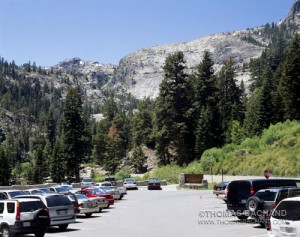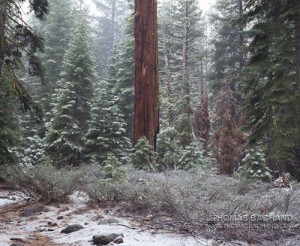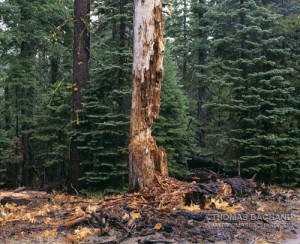
Parking Lot. Vikingsholm. Emerald Bay State Park. Lake Tahoe. Calif
It is a common fiction that the photograph is a neutral witness. Yet, every author has a bias which will find its way into the work. As such, my book of contemporary landscape photography, Lake Tahoe: A Fragile Beauty, is my story. Often discounted is the photographer’s palette, composed of such tools as lighting, camera position, camera format, lens selection, film type, and exposure, not to mention the many variables controlled after capture, during image processing and printing. Less tangible is the photographer’s worldview, psychology, and culture. More useful to the viewer than an explanation of how I take a photograph, may be a consideration of those artists to whom I have found inspiration.
In general, I find my work influenced by the historical and I see my photography as a small step in a larger continuum. More specifically, Lake Tahoe: A Fragile Beauty builds upon a number of artists. Eugene Atget, an early French photographer, made “documents for artists,” or, rather, reference photographs primarily for painters. His approach to photography was that of a utilitarian. I find a fresh, unencumbered naiveté in his work, an artist practiced with a new technology. Carleton Watkins is another historical photographer whose work I admire. As part of the United States westward migration, his work has an element of reportage, where he describes the West to eastern audiences. When I first picked up a camera, like many, I was inspired by Ansel Adams. Adams’ approach was a conscious departure from those before. Through his mastery of photographic technique, he was able to stretch the medium – manipulating film, exposure, and development to precisely achieve a desired result. I also frequently find inspiration in artists outside of photography. One such example is painter Mark Rothko, whose use of the color field draws my eye. Richard Misrach’s open skies carry this style into photography. Finally, I would like to acknowledge Larry Sultan, whom I consider a cultural anthropologist. Sultan can take a widely familiar subject, such as that of parents, and through the images of his parents we come to better understand our own parents, families, and our aging culture.
Outwardly, I worked with a large-format camera and middle-distance lenses to approximate the historical perspective of Atget and Watkins. On a subtle level this makes a visual connection between past and present. Inwardly, I approach every subject as if it is posing for both a present and future audience. What is the story behind this small slice of the landscape? What am I choosing to include and what do I discard? What is this present moment? Can I be the unbiased, empty witness?

